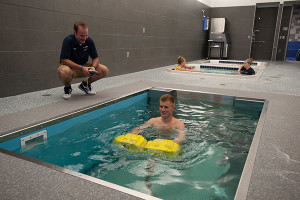Tips for Keeping Hockey Players on the Ice
We all know that ice hockey is an intense sport. Hockey pucks fly up to 100 miles per hour and players can reach speeds of 30 miles per hour on skates. Players’ basic movements, stances and motions require a significant amount of twisting and turning, putting tremendous stress on various joints. Although hockey players may be gliding while they skate, their bodies aren’t immune to the effects of gravity or momentum. That means two things: hockey players are playing hard and getting injured during the course of play. These injuries can keep them off the ice for minutes, to weeks depending on the severity of the injury.
How To Reduce Hockey Injuries
The National Athletic Trainers’ Association (NATA) highlights key recommendations to reduce the risk of injury in hockey. NATA found competition injury rates were higher than practice injury rates and that preseason practice injury rates were higher than regular season practice injury rates. HydroWorx technology has the ability to help many athletes get back to doing what they love sooner.
The majority of game and practice injuries in hockey occurred to the lower extremity. Knee injuries are the most common reported during hockey games, whereas pelvis and hip muscle strains were most common during practices. NATA states that player-to-player contact is the mechanism of injury about 50% of the time in games.
Common Hockey Injuries
Though a hockey player could experience any type of injury, there are a few that are more common, including:
- Shoulder injuries/broken collarbone
- Injuries to the groin or pelvis
- High ankle sprains
- MCL/ACL tears/sprains
- Lacerations to exposed skin, including the face
Advice For Decreasing Hockey Injuries
While injuries are always going to be a part of sports, there are some ways to reduce injuries. NATA recommends limiting the player-to-player contact in neutral zones, improvement of protective equipment (helmets, shoulder pads, etc.) and muscle specific conditioning programs.
The American Physical Therapy Association (APTA) has discovered that whether it is due to impact or overuse, the type of injury varies greatly. APTA recommends an exercise routine that includes a dynamic warm-up, cool down and overall core strengthening to prevent injuries to keep players on the ice:
- Warm up: Prepares the body for exercises by gradually increasing the heart rate and circulation. This helps to loosen the joints and increase blood flow to the muscles.
- Post-game/practice cool down: This helps heart rate and breathing to return towards resting levels gradually.
- Overall core strength: This helps train the muscles in your body
Although it is commonly assumed that these routines will be done on land, there is a lot of value in using aquatics to reduce the impact on the body. Some of the range of motion exercises athletes do regularly make the most of water’s swell-reducing compression and natural resistance (both with and without the assistance of high-powered resistance jets. These exercises include:
- Underwater walking and jogging
- Flexion and extension of the joints, such as the hip, ankle, groin or knee
- Adduction and abduction of the leg muscles
- Lateral sliding, carioca crossovers and shuffling on the underwater treadmill
Athletes tend to lean towards warm water therapy during injury progression because the buoyancy of the water, the hydrostatic pressure and warm water allow for increased range of motion. The goal for any coach or athletic trainer is solely to get the athletes back on the ice as quickly and safely as possible which is why utilizing aquatic therapy into rehab plans benefits the player and the entire team.
Click here to learn how water enhances rehabilitation for ACL recovery.>>



